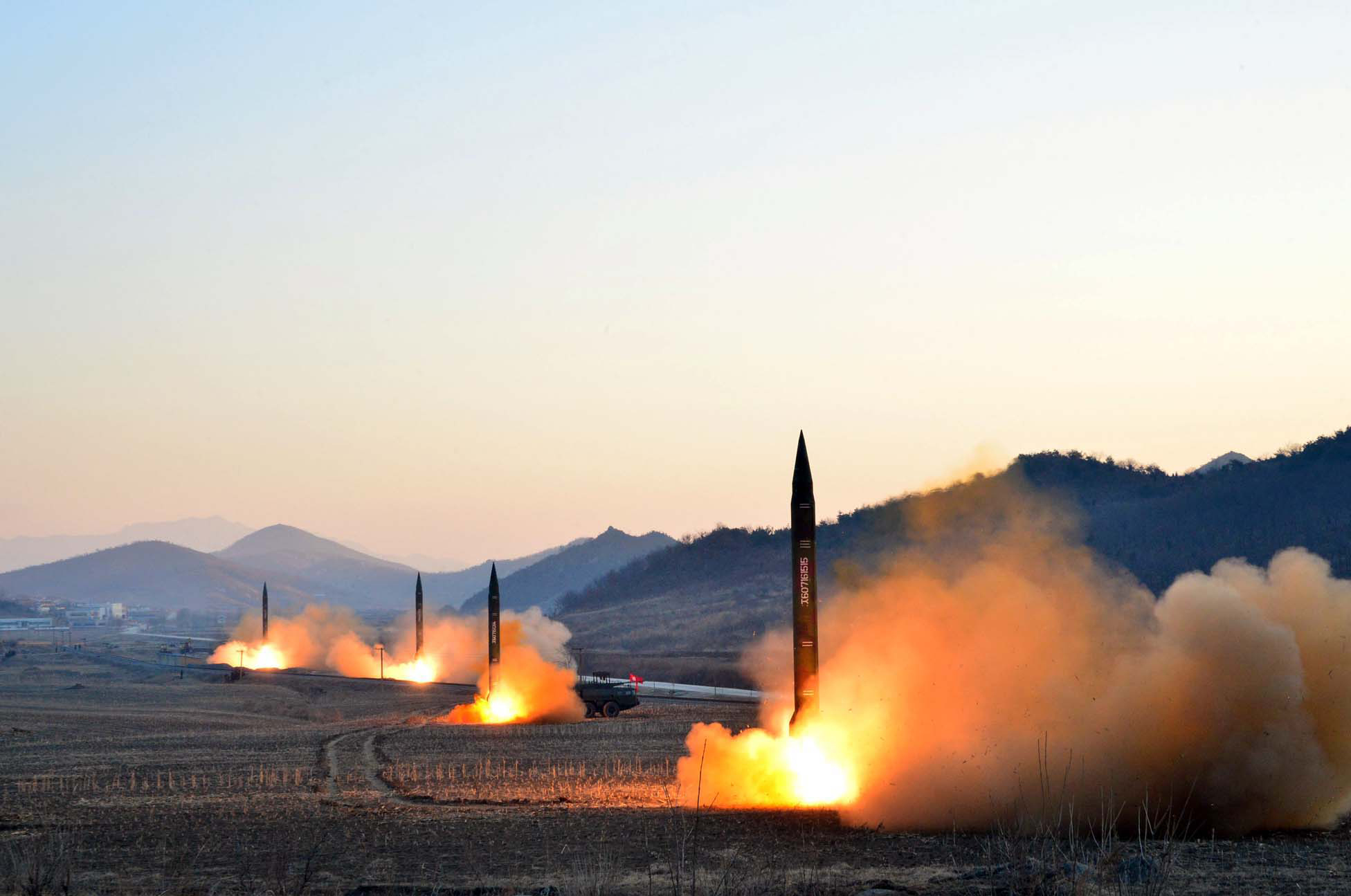Can America protect itself from North Korean missiles?
North Korea is developing nuclear weapons capable of hitting mainland America. Can anti-missile systems protect us?

North Korea is developing nuclear weapons capable of hitting mainland America. Can anti-missile systems protect us? Here's everything you need to know:
How big a threat is North Korea to the U.S.?
Experts believe that Pyongyang currently has only short- and medium-range ballistic missiles, which puts South Korea and Japan in its crosshairs. To help defend our allies, the Pentagon recently deployed a $1 billion Terminal High Altitude Area Defense system (THAAD) to South Korea. Fired from truck-mounted launchers, THAAD's interceptor missiles have a range of 125 miles and are designed to destroy short- and medium-range ballistic missiles as they descend to earth. The interceptors use infrared technology to locate their target and smash into it head-on, completely obliterating it. The Navy also has warships in the Pacific equipped with Aegis weapons systems that can fire interceptors at short- and medium-range ballistic missiles. But both of those systems are largely ineffective against intercontinental ballistic missiles (ICBMs), which fly at higher altitudes and faster speeds. And by 2020, military experts believe, North Korea will be able to build nuclear-tipped ICBMs capable of hitting the U.S. West Coast. "All the indications are that we have to be prepared to defend the homeland," Adm. Samuel J. Locklear III, then head of the U.S. Pacific Command, told Congress in 2015.
The Week
Escape your echo chamber. Get the facts behind the news, plus analysis from multiple perspectives.

Sign up for The Week's Free Newsletters
From our morning news briefing to a weekly Good News Newsletter, get the best of The Week delivered directly to your inbox.
From our morning news briefing to a weekly Good News Newsletter, get the best of The Week delivered directly to your inbox.
Could the U.S. shoot down an ICBM?
Researchers began working on anti-ICBM systems in the early days of the Cold War — focusing primarily on nuclear-tipped interceptors that were intended to explode midair and destroy the incoming enemy warhead. But most of those projects were put on hold in 1972 with the signing of the Anti-Ballistic Missile Treaty. That pact barred the U.S. and the Soviet Union from developing anti-missile systems, out of fear that one side would gain the ability to launch a first strike and then retreat behind its defenses, undermining the deterrent of "mutually assured destruction." President George W. Bush withdrew from the treaty in 2002, citing the new threat from "rogue states," like North Korea and Iran. He gave the Pentagon two years to develop what became the Ground-based Midcourse Defense (GMD) system, which debuted in 2004 and is designed to defend against an ICBM attack.
How does the system work?
It starts with infrared sensors on satellites that look for the telltale heat signature produced by ICBM rocket launches. When a launch is spotted, radar systems begin tracking the missile, which if launched from North Korea or Iran would likely fly over the Arctic Circle — the most direct route to the U.S. — reaching altitudes of nearly 250 miles and speeds exceeding 800 miles per hour. Sixty-foot-tall GMD rockets would then emerge from their silos at Vandenberg Air Force Base in Santa Barbara County, California, and Fort Greely, Alaska, and shoot into the upper atmosphere. At the edge of space, 5-foot-long, 150-pound heat-seeking interceptors known as kill vehicles would separate from their booster rockets and fly toward the incoming warhead at 4 miles per second. Dan Shanahan, a senior manager at Boeing's Strategic Missiles and Defense Systems division, likens the technically demanding feat to shooting "a bullet with another bullet in space."
A free daily email with the biggest news stories of the day – and the best features from TheWeek.com
How accurate is the system?
Not accurate enough. "Despite more than a decade of development and a bill of $40 billion, the GMD system is simply unable to protect the U.S. public," the nonprofit Union of Concerned Scientists wrote in a report last year. In nine simulated ICBM attacks since 2004, the interceptors only took out their targets three times. And unlike in a real attack, the timing, size, speed, and trajectory of the targets were known by the U.S. military in advance. "The tests are scripted for success," says Philip Coyle, a director of operational testing during the Bush administration. "What's amazing to me is that they still fail."
Why the problems?
Critics have blamed the Bush administration for fast-tracking the program and exempting the Missile Defense Agency from standard Defense Department acquisition and testing procedures — a policy continued under President Obama. The rush to get the GMD deployed resulted in "a lot of bad engineering," says Frank Kendall III, an undersecretary of defense for acquisition, technology, and logistics in the Obama administration. Each kill system has 1,000 components, and even the slightest malfunction can throw the interceptor wildly off course. The technology also has to keep working after being subjected to extreme stresses — scorching heat and violent vibrations during takeoff, and then freezing conditions outside Earth's atmosphere. In contrast to GMD, THAAD has a perfect test record, while the Aegis system has an 85 percent hit rate.
What's next for the GMD system?
The Pentagon is refining the technology and building more interceptors; the total will rise from 37 to 44 by the end of the year. But the Union of Concerned Scientists notes in its report that for the foreseeable future no missile defense system will be able to fully protect the U.S. from the threat of an ICBM strike. Even if the GMD had "an improbably high" 95 percent effectiveness against one missile, in an attack by five ICBMs there would still be a 1-in-4 chance of at least one warhead penetrating the defensive shield and potentially annihilating a U.S. city. That's "a more likely outcome," the report says, "than correctly predicting the roll of a die."
Son of 'Star Wars'
On March 23, 1983, in the waning years of the Cold War, President Ronald Reagan addressed the nation and proposed the Strategic Defense Initiative — an ambitious anti-ICBM program he hoped would render "nuclear weapons impotent and obsolete." SDI would use a network of ground- and space-based battle stations armed with lasers that could zap Soviet missiles out of the sky. Detractors nicknamed the high-tech proposal "Star Wars"; The New York Times derided it as "a projection of fantasy into policy." The project received funding in 1984 but proved to be technologically unachievable; seven years and $30 billion later, President George H.W. Bush began phasing it out. Yet the spirit of Star Wars lives on. The Missile Defense Agency announced in February that it had tested a laser-armed aerial drone, which it hopes could eventually fly high above enemy ICBM launch sites for weeks on end and zap missiles as they lifted off. "This could revolutionize missile defense," says agency spokesman Christopher Johnson.
-
 Political cartoons for December 20
Political cartoons for December 20Cartoons Saturday’s political cartoons include drowning rats, the ACA, and more
-
 5 fairly vain cartoons about Vanity Fair’s interviews with Susie Wiles
5 fairly vain cartoons about Vanity Fair’s interviews with Susie WilesCartoon Artists take on demolition derby, alcoholic personality, and more
-
 Joanna Trollope: novelist who had a No. 1 bestseller with The Rector’s Wife
Joanna Trollope: novelist who had a No. 1 bestseller with The Rector’s WifeIn the Spotlight Trollope found fame with intelligent novels about the dramas and dilemmas of modern women
-
 How do you solve a problem like Facebook?
How do you solve a problem like Facebook?The Explainer The social media giant is under intense scrutiny. But can it be reined in?
-
 Microsoft's big bid for Gen Z
Microsoft's big bid for Gen ZThe Explainer Why the software giant wants to buy TikTok
-
 Apple is about to start making laptops a lot more like phones
Apple is about to start making laptops a lot more like phonesThe Explainer A whole new era in the world of Mac
-
Why are calendar apps so awful?
The Explainer Honestly it's a wonder we manage to schedule anything at all
-
 Tesla's stock price has skyrocketed. Is there a catch?
Tesla's stock price has skyrocketed. Is there a catch?The Explainer The oddball story behind the electric car company's rapid turnaround
-
 How robocalls became America's most prevalent crime
How robocalls became America's most prevalent crimeThe Explainer Today, half of all phone calls are automated scams. Here's everything you need to know.
-
 Google's uncertain future
Google's uncertain futureThe Explainer As Larry Page and Sergey Brin officially step down, the company is at a crossroads
-
 Can Apple make VR mainstream?
Can Apple make VR mainstream?The Explainer What to think of the company's foray into augmented reality